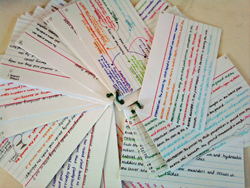2. Creating revision notes
.jpg) Making good revision notes is key. You need to consider not only range but also depth - including enough detail in your notes so that you can provide the necessary level of evidence and analysis in your your essays to support any arguments you make.
Making good revision notes is key. You need to consider not only range but also depth - including enough detail in your notes so that you can provide the necessary level of evidence and analysis in your your essays to support any arguments you make.
Here are some hints on how to go about making your revision notes!
1. What should your notes include? A Three step plan

Step One: Getting started
The very first thing that you need to do is to get organised - clear your desk, file away all loose bits of paper and tidy your work space - it really does seem to be the case that a cluttered environment is bad for revision and for memorising!
Once you have got your history notes together - consolidate your class notes, notes from textbooks etc. into revision notes (see below for more on how to do this)
Create and learn your own timelines & fact files. You need to know the chronology of events, what happened – when, and who was significant.
Create revision notes that summarise the material needed to respond to different thematic questions, for example the ideological causes of the First World War. Use the curriculum document when developing your summaries.
Once you have completed this for each of your case studies you should write ‘comparative’ summaries that consider the comparisons and contrasts between your case studies, for example the ideological causes of the First and Second World Wars (this could also be done through Venn Diagrams - see below).
Step Two: Adding depth
Synthesize historiography - you should only bring in the specific analysis of historians to your arguments when you fully understand how to analyse the material yourself. You should use historians as evidence in your arguments and not replace your analysis with vague summaries of their opinions.
Attempt to add depth in terms of the details you recall for each topic – key events dates, statistics.
Step Three: Application
Look at past paper questions and draft essay plans and more detailed essay outlines. This will allow your to check that you have enough information in your notes and also to check that you can apply your knowledge. Draw up plans and/or write essays out in full under timed conditions
You could also create your own ‘IB style’ document and essay questions. You should again have the curriculum details to hand so you can properly understand what possible questions could be asked about the material you learn.
2. How can I make note-taking a meaningful exercise?
Break down each topic into smaller parts:
Example: Paper 2. Topic 11:
Revision Topic: The Chinese Civil War
Part 1: Causes Part 2: Practices Part 3: Effects
Focus on learning the causes first. You will learn more if you focus on a sub-topic for one hour and then take a short break rather than trying to learn 15 – 20 sides of notes in a four hour cramming session. Take a break and then look at the practices in the same way.
You should underline or highlight anything you are unsure about. If by review alone you still do not fully understand a topic / part of a topic you should seek clarification from your teacher [or a reliable and capable friend!].
Make sure you personalise your notes. Be creative - use colours and images. Decide on abbreviations and how to cross-reference notes between sections. The more creative you are with your revision notes, the more likely it is that the information will be stored in your long-term memory.
Specifically think about using the following:
1. Timelines.
As suggested in Step 1 above, these are an excellent way of sorting out chronology and helping you to understand the importance of different events. A time line can also be manipulated to help you analyse different issues.
Examples of how you can do this can be found here:
1.2 Theme 1 - Rivalry, Mistrust and Accord (ATL) under Section 8: Reviewing the events of the Cold War or
Case Study: Vietnam War (ATL) under Guiding question 2, Task Five.
2. Using grids
Organizing information in different ways is very important. Grids can help you to look at your knowledge in a thematic way and also help you see links between topics more clearly.
You can find examples of such grids on these pages:
Case Study: Vietnam War (ATL) under Guiding Question Five, Task Three
2. Theme 2 - Leaders and Nations (ATL) under Guiding Question One, Task One
3. Japanese expansion in East Asia (1931 - 1941) (ATL) under Guiding Question Six, Task Three
Comparative essay planning for authoritarian states
3. Mind Maps
.png)
From Causes and Practices of 20th Century Wars, Jo Thomas and Keely Rogers, Pearson
For visual learners, drawing mind maps or spider diagrams or other infographics can be a valuable exercise for organising information and seeing connections.
4. Using revision cards

You may want to condense notes onto revision cards which can be easily carried around. Consider writing a question on the front and putting the key points to the answer on the back of the card so that you can test yourself easily - or make it easy for other people to test you.
5. Venn Diagrams
.png)
For Paper 2 topics you must ensure that you have considered the comparisons and contrasts between your case studies. For example the similarities and differences in how Mao in China and Hitler in Germany consolidated control, or the causes of the Spanish and Cuban civil wars. Venn diagrams can be a useful way of doing this.

 IB Docs (2) Team
IB Docs (2) Team
